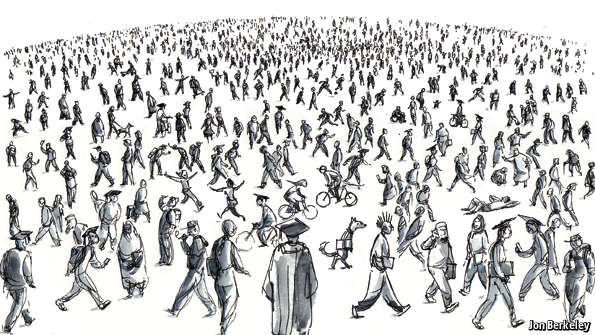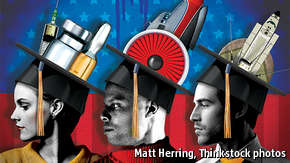by Biodun Iginla, News Analyst, The Economist and BBC News
The world is going to university
More and more money is being spent on higher education. Too little is known about whether it is worth it

America’s early and lasting enthusiasm for higher education has given it the biggest and best-funded system in the world. Hardly surprising, then, that other countries are emulating its model as they send ever more of their school-leavers to get a university education. But, as our special report argues, just as America’s system is spreading, there are growing concerns about whether it is really worth the vast sums spent on it.
The American way
The modern research university, a marriage of the Oxbridge college
and the German research institute, was invented in America, and has
become the gold standard for the world. Mass higher education started in
America in the 19th century, spread to Europe and East Asia in the 20th
and is now happening pretty much everywhere except sub-Saharan Africa.
The global tertiary-enrolment ratio—the share of the student-age
population at university—went up from 14% to 32% in the two decades to
2012; in that time, the number of countries with a ratio of more than
half rose from five to 54. University enrolment is growing faster even
than demand for that ultimate consumer good, the car. The hunger for
degrees is understandable: these days they are a requirement for a
decent job and an entry ticket to the middle class.There are, broadly, two ways of satisfying this huge demand. One is the continental European approach of state funding and provision, in which most institutions have equal resources and status. The second is the more market-based American model, of mixed private-public funding and provision, with brilliant, well-funded institutions at the top and poorer ones at the bottom.
The world is moving in the American direction. More universities in more countries are charging students tuition fees. And as politicians realise that the “knowledge economy” requires top-flight research, public resources are being focused on a few privileged institutions and the competition to create world-class universities is intensifying.
In some ways, that is excellent. The best universities are responsible for many of the discoveries that have made the world a safer, richer and more interesting place. But costs are rising. OECD countries spend 1.6% of GDP on higher education, compared with 1.3% in 2000. If the American model continues to spread, that share will rise further. America spends 2.7% of its GDP on higher education.
If America were getting its money’s worth from higher education, that would be fine. On the research side, it probably is. In 2014, 19 of the 20 universities in the world that produced the most highly cited research papers were American. But on the educational side, the picture is less clear. American graduates score poorly in international numeracy and literacy rankings, and are slipping. In a recent study of academic achievement, 45% of American students made no gains in their first two years of university. Meanwhile, tuition fees have nearly doubled, in real terms, in 20 years. Student debt, at nearly $1.2 trillion, has surpassed credit-card debt and car loans.
None of this means that going to university is a bad investment for a student. A bachelor’s degree in America still yields, on average, a 15% return. But it is less clear whether the growing investment in tertiary education makes sense for society as a whole. If graduates earn more than non-graduates because their studies have made them more productive, then university education will boost economic growth and society should want more of it. Yet poor student scores suggest otherwise. So, too, does the testimony of employers. A recent study of recruitment by professional-services firms found that they took graduates from the most prestigious universities not because of what the candidates might have learned but because of those institutions’ tough selection procedures. In short, students could be paying vast sums merely to go through a very elaborate sorting mechanism.
If America’s universities are indeed poor value for money, why might that be? The main reason is that the market for higher education, like that for health care, does not work well. The government rewards universities for research, so that is what professors concentrate on. Students are looking for a degree from an institution that will impress employers; employers are interested primarily in the selectivity of the institution a candidate has attended. Since the value of a degree from a selective institution depends on its scarcity, good universities have little incentive to produce more graduates. And, in the absence of a clear measure of educational output, price becomes a proxy for quality. By charging more, good universities gain both revenue and prestige.
What’s it worth?
More information would make the higher-education market work better.
Common tests, which students would sit alongside their final exams,
could provide a comparable measure of universities’ educational
performance. Students would have a better idea of what was taught well
where, and employers of how much job candidates had learned. Resources
would flow towards universities that were providing value for money and
away from those that were not. Institutions would have an incentive to
improve teaching and use technology to cut costs. Online courses, which
have so far failed to realise their promise of revolutionising higher
education, would begin to make a bigger impact. The government would
have a better idea of whether society should be investing more or less
in higher education.Sceptics argue that university education is too complex to be measured in this way. Certainly, testing 22-year-olds is harder than testing 12-year-olds. Yet many disciplines contain a core of material that all graduates in that subject should know. More generally, universities should be able to show that they have taught their students to think critically.
Some governments and institutions are trying to shed light on educational outcomes. A few American state-university systems already administer a common test to graduates. Testing is spreading in Latin America. Most important, the OECD, whose PISA assessments of secondary education gave governments a jolt, is also having a go. It wants to test subject-knowledge and reasoning ability, starting with economics and engineering, and marking institutions as well as countries. Asian governments are keen, partly because they believe that a measure of the quality of their universities will help them in the market for international students; rich countries, which have more to lose and less to gain, are not. Without funding and participation from them, the effort will remain grounded.
Governments need to get behind these efforts. America’s market-based system of well-funded, highly differentiated universities can be of huge benefit to society if students learn the right stuff. If not, a great deal of money will be wasted.


No comments:
Post a Comment